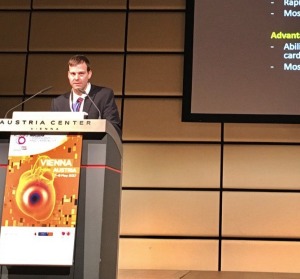by
Lauren Dubinsky, Senior Reporter | May 12, 2017

Dr. Edward Hulten speaking at ICNC 2017
Photo by: Nishant R. Shah via Twitter
The International Atomic Energy Agency recommendations to reduce nuclear cardiology radiation exposure were published last year, but not many facilities have put them into practice.
These were the findings of a new study presented on Tuesday at the International Conference on Nuclear Cardiology and Cardiac CT 2017 that included data from 65 countries.
Nuclear cardiology is an integral part of contemporary cardiology management and about 15 to 20 million procedures are performed per year, according to Dr. Edward Hulten, cardiologists at the Walter Reed National Military Medical Center, who presented the study.



Ad Statistics
Times Displayed: 7172
Times Visited: 104 Fast-moving cardiac structures have a big impact on imaging. Fujifilm’s SCENARIA View premium performance CT brings solutions to address motion in Coronary CTA while delivering unique dose saving and workflow increasing benefits.
"Concerns have been raised about tests, including nuclear cardiology, that expose patients to ionizing medical radiation," he added. "Medical radiation potentially raises the lifetime risk of cancer, which is important for all patients, especially younger patients or when considering additional radiation over time from further medical studies."
The American Society of Nuclear Cardiology recommended 9mSv or less radiation exposure per scan in 2010. It was noted in the 2016 International Atomic Energy Agency nuclear cardiology guideline, but the agency didn't formally endorse it as a recommendation.
The IAEA developed eight quality metrics for responsible radiation use in nuclear cardiology. They instructed facilities to avoid thallium 201 stress testing, dual isotope testing, too much technetium-99m and thallium 201, and inappropriate dosing that causes artifacts, and to use stress-only imaging, camera technologies, and weight-based dosing strategies for technetium-99m.
The IAEA Nuclear Cardiology Protocols Study evaluated adherence to the eight quality metrics during one week in 2013. The study included 7,911 nuclear cardiology scans from nuclear cardiology labs in 65 countries in Africa, Asia, Europe, Latin America, North American and Oceania.
The researchers found significant variability in the adherence to the quality metrics across all labs and regions. Overall, there was a low rate of adherence with most sites implementing less than half of the metrics.
After performing a multivariable logistic regression analysis, they revealed that use of stress- or rest-only imaging, avoiding thallium and using camera technologies were the practices that most often achieved a 9mSv or less scan.
"When the 9 mSv recommendation was made in 2010 it was suggested that it should be achieved in 50% of scans by 2014," Hulten said in a statement. "The INCAPS [study] shows that there is still work to do."
Not every facility has the hardware and technology needed to reduce dose, but Hulten affirms that money is not needed for everything. For example, multiple position imaging, weight-based dosing and stress-only techniques require adapting existing workflows.

